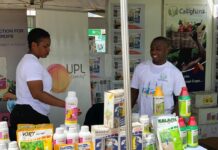Figures highlight ongoing severity of disease outbreak – expert
Ghana previously said 25.7% of total cocoa growing land infected
By Maytaal Angel
LONDON, July 18 (Reuters) -A major cocoa producing region in Ghana, the world’s second largest cocoa grower, is 81% infected with swollen shoot disease, according to the International Cocoa Organisation (ICCO).
Prices for the chocolate ingredient have roughly doubled this year because of adverse weather and disease in top cocoa producers Ghana and Ivory Coast, but hopes are rising for improved output next season.
The two countries together produce about 60% of the world’s cocoa.
Dashing output recovery hopes somewhat are the figures on bean disease in Western North, Ghana’s third largest cocoa region by output, which highlight the ongoing severity of the outbreak.
Swollen shoot virus first reduces yields before killing trees, usually within a few years. Once infected, trees must be ripped out and the soil treated before cocoa can be replanted.
According to the ICCO, Ghana’s Western North region covers an area of 410,229 hectares and has 330,456 hectares infected. The intergovernmental body was citing data from the Cocoa Health and Extension Division (CHED) of Cocobod, Ghana’s cocoa industry regulator.
In April, the chief executive of that industry regulator, Joseph Aidoo, told Reuters at an industry event that a total of 500,000 hectares were infected in the country at large – equivalent to 25.7% of Ghana’s 1.94 million hectares of cocoa growing land.
Another 100,000 hectares is unproductive due to aged trees, he said, and the country has so far treated a separate 100,000 hectares for swollen shoot. After rehabilitation, replanted trees take two to four years to mature and produce beans.
“Swollen shoot is clearly a serious problem that’s not improved in the last 12 months and is not going away,” said Steve Wateridge, a veteran world expert on cocoa and head of research at Tropical Research Services by Expana.
The ICCO said swollen shoot is also spreading in Ivory Coast, though authorities there have been more circumspect about revealing the extent of the outbreak publicly.
Wateridge previously told Reuters that up to 30% of Ivorian cocoa plantations were likely infected.
Ghana traditionally produces more than 800,000 tons of cocoa a year, but is expected to produce just over half that amount this season because of disease, aging trees, illegal gold mining, climate change and smuggling.








